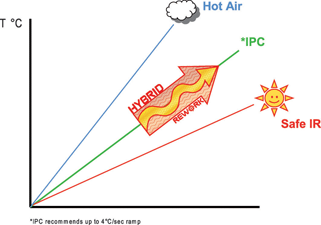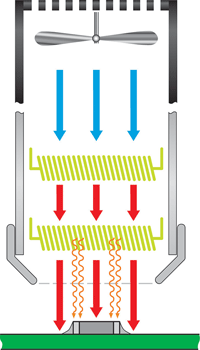
This article looks at some of the technical issues and market requirements behind this new technology, which embraces the term 'hybrid' as more than just a marketing slogan.
Looking back to the 'leaded age'
During the days of tin-lead alloys when SMDs were externally leaded devices, rework and repair of such components could be undertaken without too much difficulty. Both contact heating systems, such as soldering irons and heated tweezers, and non-contact systems such as hot air guns, were viable alternatives for bench-top rework. The process control requirements for such systems were not particularly high as the soldering processes and components themselves were, for the most part, 'forgiving'.
Since the introduction, however, of ball grid array (BGA) components, the rules for rework have changed significantly. Non-contact heating technologies were the only option for exchanging such components and hot air systems were the accepted state of the art.
In 1997, ERSA entered the BGA rework market with the launch of a completely new technology designed specifically for reworking area array devices. Rework specialists could now choose between the commonly-used hot air systems and ERSA's new, medium wavelength IR systems.
Traditional convection systems bundle the heat energy more strongly via the hot air nozzle and thus achieve somewhat faster cycle times. Medium wavelength infrared radiation on the other hand, guarantees uniform heat distribution across the BGA package and is characterised as a slower and safer process.
New, lead-free components
The ever increasing demands on today's electronic assembly have not only targeted the components but also the alloys. The introduction of lead-free solders represents a milestone for both production and repair equipment requirements. Modern rework systems are faced with the following challenges:
* Efficient soldering and desoldering of target components without damaging them (as per IPC requirements at a maximum. temperature gradient of 4°C/s).
* Bringing the heat energy onto the target component in as focused a manner as possible without influencing or destroying neighbouring parts and/or substrates.
* Creating stable, reproducible and documentable processes.
* Simple but modular operating concept for both beginner and professional users.
The smaller process windows and higher process temperatures of lead-free soldering place ever greater demands on contemporary rework systems. More power on the one hand (in order to handle higher temperatures) and more control for temperature-sensitive components on the other hand, is a paradox in itself and is an extremely difficult balancing act to manage.
When it comes to handheld, hot air guns, there is the ever present problem of unintentionally overheating and blowing away an adjacent small chip during the repair. On the other hand, many large companies are banning contact heat methods with hot tweezers for rework due to the possibility of thermally shocking small ceramic condensers. Given these two extremes, how should or could safe repair of 0402 and 0201 components now be achieved?
Today's technical requirements for a compact bench-top rework system
The technical requirements can be divided into three groups: 'absolutely essential', 'highly practical' and 'nice to have but not essential'. The requirements for 'absolutely essential' include: fast rework cycle, low cost of system and small size, option of implementing a repair in the unit housing, flexibility and process security. The requirements for 'highly practical' are: process stability and repeatability, simple operation and simple operator training. The 'nice to have but not essential' requirements include: software support, use of temperature profiles, documentation and traceability.
As a manufacturer of both rework systems and high-end reflow systems worldwide, ERSA has a large amount of experience in the area of convection soldering with hot air or hot gas. The decision taken 10 years ago to use medium wavelength infrared radiation instead of hot air for rework, however, was well thought out and has paid off.
Rework is a selective soldering process which has the more difficult task of uniformly heating only one component. For this reason, the limitations of hot air in a rework environment caused ERSA engineers to look for a more viable alternative. The solution was found in infrared radiation technology and today, ERSA IR rework systems are leaders on the global market with many thousands of systems sold.
ERSA soldering irons and hand tools have also been very popular since their inception in 1921. Looking at the hand tool range of ERSA products with respect to rework, however, there has always been a large gap between the soldering irons and desoldering tweezers in the lower-end product range and the larger, more expensive semi-automatic IR rework systems in the upper segment. ERSA has consequently researched a solution to not only fill this gap but also to address certain repair needs in today's lead-free rework environment. The answer was found in combining two familiar technologies.
Hybrid - the best of both worlds
As already stated, both technologies, hot air and medium wavelength infrared, have their strengths and weaknesses, depending on the application. With hot air, one can achieve high temperature gradients of up to 10°C/s and more, for example if the component to be desoldered is already defective and if no smaller, neighbouring components can be over-heated in the process of removal.
Such gradients are not permitted, however, for safe re-soldering as specified by IPC which specifies a maximum gradient of 4°c/sec. ERSA's medium wavelength infrared radiation allows for a maximum temperature gradient of approximately 2°C/s (see Figure 1). While this technology is safe, it can be rather slow. A combination of hot air and medium wavelength infrared radiation offers a perfect alternative rework solution.

Profiting from its experience with both infrared rework systems and convection reflow soldering machines, ERSA has combined both heating technologies into one system. The Hybrid Rework System HR 100 combines infrared and convection heating in a handheld device for safely soldering and desoldering densely packed SMDs (see Figures 2 and 3).


Part 2 will follow in a future issue.
| Tel: | +27 11 824 1427 |
| Email: | [email protected] |
| www: | www.techmet.co.za |
| Articles: | More information and articles about Techmet |

© Technews Publishing (Pty) Ltd | All Rights Reserved